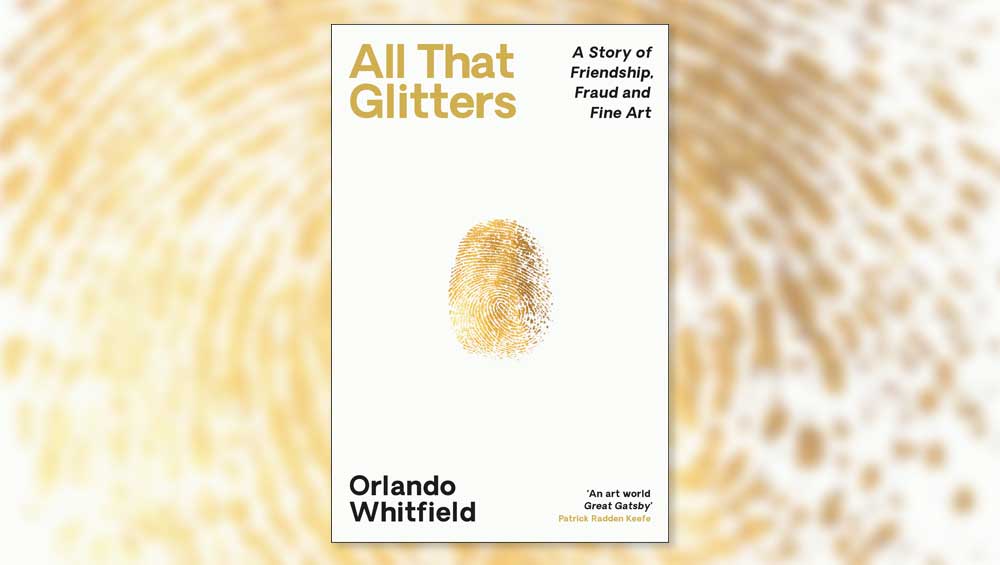
All That Glitters: A Story of Friendship, Fraud and Fine Art by Orlando Whitfield, published by Profile.
by CHRISTIANA SPENS
At the heart of All That Glitters is a fraud. The memoir of the self-described “failed art dealer” Orlando Whitfield recounts his long friendship with the disgraced (and convicted) dealer Inigo Philbrick, who was released from prison this year. Philbrick is the roguish product of an unregulated artworld and, for a time, Whitfield was his right-hand man. Entranced by him since they were students together at Goldsmiths, University of London, and sharing his love of fine art and the glamour that surrounds it, Whitfield was more than happy to go into business with the charismatic Philbrick before they had even graduated.
The author’s very real love of art is catching, as is his early excitement about the “alchemy” that accompanies it, where dealing seems at times like conjuring money out of thin air. An early deal, in which they sell a Paula Rego drawing, is exhilarating; some attempts to obtain Banksy pieces are comical if doomed, and while Whitfield is not the mastermind behind these adventures, he is drawn into the excitement of the gambling, led on by his bright, secretive friend. Compulsion runs through the book in myriad ways, from the addiction to this unregulated betting and selling, to the relatively calming activity of archiving, counting and collecting, to the collective dependencies on alcohol, drugs and general consumption.
Of course, as with any toxic relationship, and its attendant vice, the initial thrills are gradually offset with crashing lows and perpetual anxiety; the experience of being lied to repeatedly, driven crazy by Philbrick’s double-crossing, gameplaying, silence and broken promises, is painful to watch. Whitfield has seen Philbrick treat others in this way, and yet naively never quite believes that he will also be treated with such disrespect. Why would Philbrick taunt his once close friend with late payments, lies and the passive cruelty usually reserved for his clients? How could Whitfield have thought himself – or been foolish enough to wish himself – immune from the deception and exploitation he had witnessed so many times, directed at other people?
Shortly after a high-pressure deal almost falls through in these circumstances, risking a huge amount of money, Whitfield falls into a crashing depression and finds himself on a psychiatric ward, on suicide watch. In the midst of this deep disillusionment with the art world, it is just his luck that he meets a “very famous artist” on the same ward, who also warns him off his career of choice. “This your first time here?” he asks Whitfield, who nods and then tells the artist about his own gallery and his desire to quit. “The art world’s not what you think it is, trust me,” he warns. “Get out while you still can.”

Orlando Whitfield. Photo: Robin Christian.
All That Glitters is about ambition, narcissism and machiavellianism as much as it is about art; it is a portrait of a man who sees people as things to control and use, who considers relationships as transactional, who exploits those around him and preys on others in the most cynical ways. But the author is clearly dazzled by him, at least in the beginning; and when he is no longer deceived by this glamour, he wants to understand it, as if knowing the inner workings of this character will offset the sense of betrayal that lingers still — as if, somehow, despite everything, there is something to be found that will make the rest worthwhile.
At various points throughout All That Glitters, the author wonders what Philbrick could possibly see in him. Why should he have Whitfield hanging around, taking his cut on deals that he has masterminded? Why should he divide his takings at all? What could he hope to get back? But this book is the answer to that question; in listening so well, Whitfield has a story to tell – starring Philbrick. In the author’s seeming subservience, his genuine awe, his friendship, he pays close attention to such a degree that there is a whole memoir charting the rise and fall of an art world star, the descent being the most interesting thing about it.
This is a story about friendship, which is a sort of love, and the author’s attempts to reconcile his real affection for someone who turns out to be a fraud. Just how was he deceived and betrayed, and did he lean into that delusion? Does this mean the friendship he had for Philbrick was not real, was somehow inauthentic? Or, like the painting that Philbrick covertly bought against the artist’s instructions, after the latter had disowned it on account of water damage, and then sneakily had it restored, making a massive profit on its resale — was this careful deception a kind of art? There is a song, It’s Only a Paper Moon, that Blanche DuBois, the tragic heroine of Tennessee Williams’ play A Streetcar Named Desire, sings as she clings on to her delusions even as they fall around her: “Say it’s only a paper moon / Sailing over a cardboard sea. / But it wouldn’t be make-believe / If you believed in me.”
This is the delusion that is so enthralling, and there is something unbearably sad about loving someone who has told so many lies in their life that there is no significant difference between a lie and a truth any more. They are unreachable, and yet always reaching, lost between reality and a dream of themselves. In Whitfield’s portrait of Philbrick, he casts a light on the art world more broadly, an industry predicated on half-truths and illusions, a need for something more, often something out of nothing. It is damning and yet painfully relatable; it is very human. His Philbrick is a magpie, cunning and coveting, and yet in a way he is only an extreme version of what many of us are; he is simply more brazen, a shining mirror of the industry.
So, why would Philbrick want someone like Whitfield hanging around? Precisely for this insight, this story, written so beautifully – it is a priceless thing, however damning. Philbrick himself sent Whitfield much of the material on which he has based this book – email chains between Philbrick and the gallerist Jay Jopling, notes, receipts – in the hope that Whitfield would write something that would help defend his reputation. But Whitfield had his own observations, too.
I am reminded of Janet Malcolm’s article in the New Yorker The Journalist and the Murderer, on this point, about a reporter who becomes friends with a convicted killer so as to write a book about him, and the ethical complexities of such a case.
“The catastrophe suffered by the subject is no simple matter of an unflattering likeness or a misrepresentation of his views; what pains him, what rankles and sometimes drives him to extremes of vengefulness, is the deception that has been practised on him. On reading the article or book in question, he has to face the fact that the journalist – who seemed so friendly and sympathetic, so keen to understand him fully, so remarkably attuned to his vision of things – never had the slightest intention of collaborating with him on his story but always intended to write a story of his own.”
Malcom’s seminal work is a harsh critique of journalists and their vocation, and not necessarily true of every case, but it is important to look closely at the dynamic between writer and subject, and what goes on in that interaction, and the author considers this too. “I never asked Inigo to tell me his story, to send me the documentation – but I believe he hoped to get something in return: he wanted me to tell not just his side of the story, but his version of the truth. But the time I had read the documents in their entirety, however, any collaboration between him and me had become impossible. I had to go it alone. This was not an easy decision … I spent so much of the past two years wanting to believe Inigo’s version of events, defending him to friends, feeling outrage at his treatment in the media.” But in the end, the author comes to a different conclusion, with more emotional distance: “I had to conclude what I believe no one could fail to: that these were not wholly the actions of a young man who got in too deep, but rather those of a charming and devious fraudster, too.” It is this reflection, and admission of his own fallibility, that is particularly arresting.
There is a sense, too, that after all the excess and corruption thus observed, something genuinely valuable has been produced – a work of art chiselled out of the raw material of Whitfield’s memories and receipts of a turbulent time. The ethics of memoir writing can be as hazy as those of art dealing, and in both worlds, we hold up a work of art as our trophy and our defence, a shield made of something that glitters, perhaps gold.
Towards the end of this story, after his breakdown, Whitfield pivots from art dealing to conservation. When his father dies, a week into an impromptu “work experience” placement, Whitfield takes solace in the methodical processes he learns under the tutelage of the conservator Piers Townshend, and an experiment turns into a career. That, and writing. I find this chapter to be the most moving part of the book, where Whitfield must accept the loss of his father, saying goodbye to his still body, and then sets about restoring tiny details of precious paintings.
In the aftermath of Philbrick’s arrest, with reams of notes and chains of emails with which Philbrick has supplied him, Whitfield also sets about the task of piecing together this lost friendship and the chaos that Philbrick left in his wake. Writing, like conservation, takes what is left, pieces it back together, and keeps it intact, careful to guard the remainders of life, perhaps the essence of it, against the ravages of time. While there is an element of conservation and writing that is predicated on a refusal to let go, to accept what is damaged, Whitfield has found in both pursuits a new kind of alchemy – one that is not fraudulent in the way that those art dealing practices of the past were, but that is rooted nevertheless in a stubborn wish to hold on to something so precious and rare.
• All That Glitters: A Story of Friendship, Fraud and Fine Art by Orlando Whitfield is published by Profile, price £20.